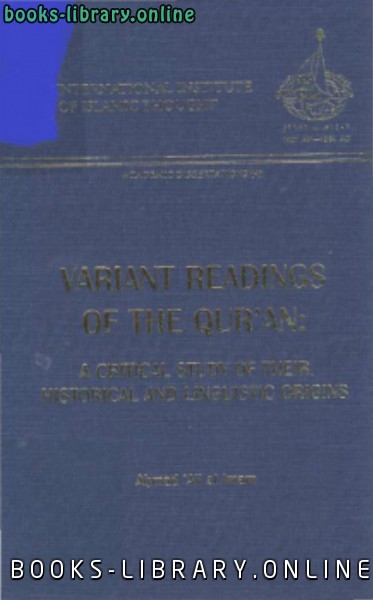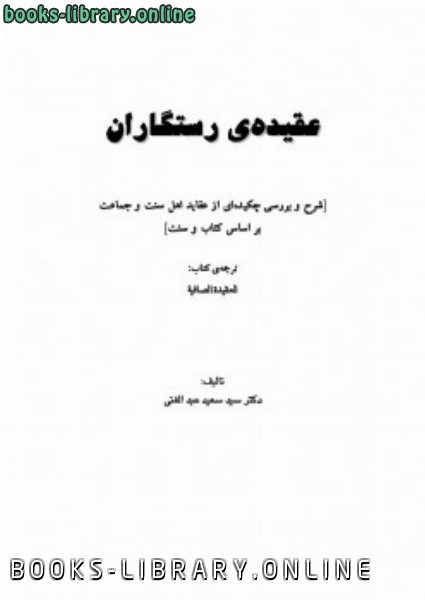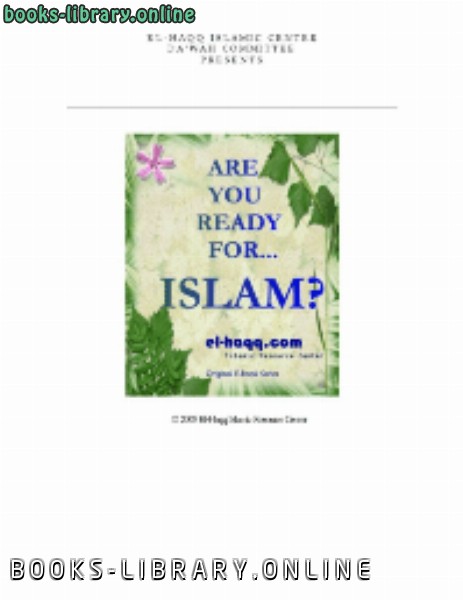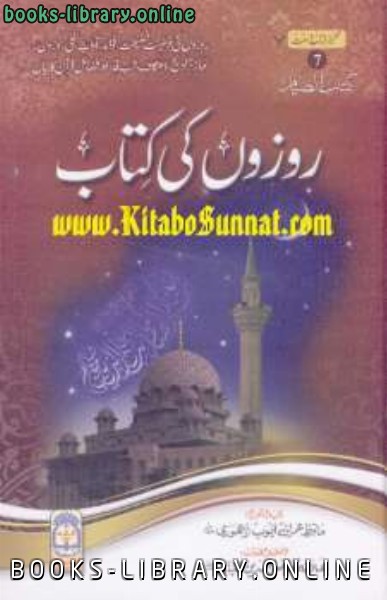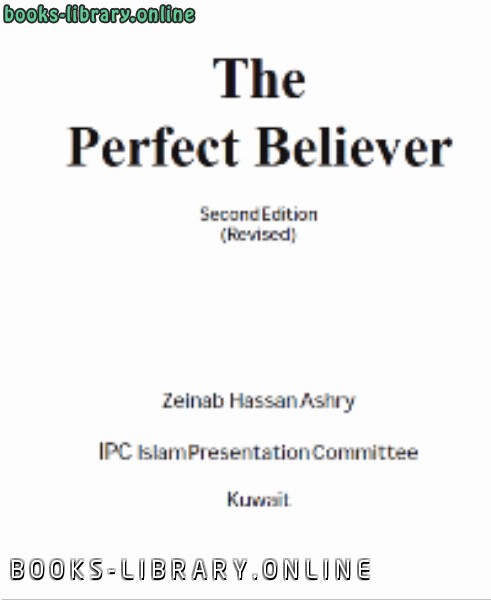كتاب VARIANT READINGS OF THE QUR AN A CRITICAL STUDY OF THEIR HISTORICAL AND LINGUISTIC ORIGINS
This book has multiple significance and is related to diverse fields of interest. Therefore, its subject occupies a distinctive place in the field of Qur'anic studies in particular, and Islamic studies in general. Moreover, this is a subject that, at times transcends the field of essential or funda- mental Islamic studies and moves into the sphere of subjects like language, rhetoric, and logic. There are a number of possible approaches to deal with this subject, and it is essential to distinguish between them and then to choose the best. For example, one may study the relationship between the Quran and the Sunnah of the Prophet; the essential differences between the Book and the Sunnah; the Arabic language and its capacity for expressing, with power, divine revelation; the extent to which the human tongue is capable of deal- ing with a language that served as a conduit for the Divine, in terms of the ease or difficulty of pronunciation or understanding; or its capacity to deal with, and to comprehend, the changes that inevitably occur in the organi- zation, style, expressiveness, and illimitability of languages. Some of the most important issues to be dealt with in this field have come to us through hadith narrations of varying degrees of authenticity (or the lack thereof), particularly those concerning the plurality of Qur'anic recitations, the ways that these were passed down, and the relative renown of each. Witness, for example, the hadith concerning the "seven letters" and the many different narrations in its support. Thus, it is fitting that our approach to this book be the study of the relationship between the Blessed Book and the Sunnah of the Prophet. In doing so, I hope that I may pro- vide a framework from which to read and understand this book appropri- ately. Imam Shafi'i defined the relationship between the Book and the Sunnah in a very precise manner, though most scholars, owing to their pre- occupation with jurisprudence, have not paid attention to the subtleties in his definition. Thus, most interpretations of Imam Shafi'i's definition of that relationship are less than satisfactory. In his work on jurisprudence, AI Risa/iih, Imam Shafi'i explained the place of the Sunnah in terms of eluci- xiii dation, or bayan. As such, the Sunnah represents one form among many that brings lucidity to the Qur'an. At times, the Qur'an is perfectly clear, immediately apparent, and requires no further elucidation. At other times, the meaning of its verses is explained by other verses, or the meaning is interpreted over the course of time. In most instances, however, the mean- ing is clarified by means of the Sunnah, either by word or in deed. This is because the basic function of the Sunnah is to elucidate. Furthermore, the elucidator is subservient to the elucidated which, in this case, equates with the text of the Qur'an. Imam Shafi'i affirmed that the Qur'anic text occupies the highest pos- sible place and that nothing can compare or compete with it (in terms of its significance) other than something that is equal to it (i.e., another verse from the Qur'an). He then went on to generate a number of particular instances from this principle, although owing to their intricacies, many of these, too, were misunderstood. Then, given his understanding of the rela- tionship, and his limiting the concept of "text" or na$$ to the Qur'an alone, A book, in pdf format, written by Ahmed Ali Al-Imam, a serious critical and critical studies that dealt with the various readings of the Holy Qur'an, and the author highlights their historical and linguistic origins. The book begins by talking about the seven letters, and in the second chapter it talks about the codification of the Holy Quran, how it was formed in the era of Abu Bakr, may Allah be pleased with him, and how it was in the era of Uthman ibn Affan may Allah be pleased with him. The third chapter talks about the development of the Ottoman Koran, chapter four and fifth on the language of the Holy Quran, and then speaks in chapter six about the origin of the various readings of the Holy Quran, and concludes with an important chapter on selection and weighting in the issue of readings.احمد على الامام - حمد علي الإمام( 1945-2012)..عالم دين سوداني ولد بمدينة دُنْقُلا بشمالي السودان، (1364هـ - 1945 نشاته وتعليمه تلقى تعليمه في المرحلة الابتدائية بمعهد دنقلا العلمي وتلقى تعليمه الثانوي في معهد أم درمان العلمي، بأم درمان تخرج من جامعة أم درمان الإسلامية عام 1974 - حفظ القرآن يافعاً في خلوة الشيخ صالح علي الأزهري، تعلَّم على يد الشيخ محمد إبراهيم الطيب، وتلقى علوم الفقه واللغة على يد والده الشيخ علي الإمام، ثم على علماء عصره - حصل على درجة الدكتوراه من جامعة أدنبرا، بريطانيا، في علوم القرآن، مع عناية خاصة بنقد أعمال المستشرقين في لغويات وتاريخ القرآن. الوظائف التي شغلها عمل محاضراً بجامعة أم درمان الإسلامية. عمل في وزارة التربية والتعليم معلمًا بمدارسها الثانوية في دنقلا ومدني. عمل بالتدريس في الكلية الإسلامية في زنجبار بتنزانيا، وحقل الدعوة الإسلامية بشرق إفريقيا (1974- 1978م). عمل محاضرًا بجامعة أم درمان الإسلامية منذ 1979م، ثم انتقل للعمل لفترة محاضرًا بجامعة أدنبرة. عمل مديرًا للمركز الإسلامي بأدنبرة، ورئيسًا لاتحاد الطلاب المسلمين في جامعات أدنبرا، ثم كان رئيسًا لاتحاد طلاب الدراسات العليا في جامعة أدنبرا. عمل مديراً لجامعة القرآن الكريم والعلوم الإسلامية في السودان. الوظائف التنفيذية التي تقلدها: شغل منصب الأمين العام لهيئة علماء السودان . ثم عمل مديرًا لجامعة القرآن الكريم والعلوم الإسلامية في السودان . ثم شغل منصب رئيس مجمع الفقه الإسلامي السوداني. ثم عمل مستشارًا لرئيس الجمهورية لشئون التأصيل والتخطيط الإستراتيجي منذ مارس 1998م حتى الفترات الأخيرة لوفاته حتى أُعفي منها نسبة لمعاناته مع المرض الذي ألزمه الفراش الأبيض منذ العام 2011م حتى وافته المنية اليوم الثلاثاء الـ30من أكتوبر للعام2012 ❰ له مجموعة من الإنجازات والمؤلفات أبرزها ❞ VARIANT READINGS OF THE QUR 039 AN: A CRITICAL STUDY OF THEIR HISTORICAL AND LINGUISTIC ORIGINS ❝ ❞ VARIANT READINGS OF THE QUR AN A CRITICAL STUDY OF THEIR HISTORICAL AND LINGUISTIC ORIGINS ❝ ❱
من كتب إسلامية بلغات أخرى - مكتبة كتب إسلامية.

قراءة كتاب VARIANT READINGS OF THE QUR AN A CRITICAL STUDY OF THEIR HISTORICAL AND LINGUISTIC ORIGINS أونلاين
معلومات عن كتاب VARIANT READINGS OF THE QUR AN A CRITICAL STUDY OF THEIR HISTORICAL AND LINGUISTIC ORIGINS:
This book has multiple significance and is related to diverse fields of
interest. Therefore, its subject occupies a distinctive place in the field of
Qur'anic studies in particular, and Islamic studies in general. Moreover,
this is a subject that, at times transcends the field of essential or funda-
mental Islamic studies and moves into the sphere of subjects like language,
rhetoric, and logic.
There are a number of possible approaches to deal with this subject,
and it is essential to distinguish between them and then to choose the best.
For example, one may study the relationship between the Quran and the
Sunnah of the Prophet; the essential differences between the Book and the
Sunnah; the Arabic language and its capacity for expressing, with power,
divine revelation; the extent to which the human tongue is capable of deal-
ing with a language that served as a conduit for the Divine, in terms of the
ease or difficulty of pronunciation or understanding; or its capacity to deal
with, and to comprehend, the changes that inevitably occur in the organi-
zation, style, expressiveness, and illimitability of languages.
Some of the most important issues to be dealt with in this field have
come to us through hadith narrations of varying degrees of authenticity (or
the lack thereof), particularly those concerning the plurality of Qur'anic
recitations, the ways that these were passed down, and the relative renown
of each. Witness, for example, the hadith concerning the "seven letters"
and the many different narrations in its support. Thus, it is fitting that our
approach to this book be the study of the relationship between the Blessed
Book and the Sunnah of the Prophet. In doing so, I hope that I may pro-
vide a framework from which to read and understand this book appropri-
ately.
Imam Shafi'i defined the relationship between the Book and the
Sunnah in a very precise manner, though most scholars, owing to their pre-
occupation with jurisprudence, have not paid attention to the subtleties in
his definition. Thus, most interpretations of Imam Shafi'i's definition of
that relationship are less than satisfactory. In his work on jurisprudence, AI
Risa/iih, Imam Shafi'i explained the place of the Sunnah in terms of eluci-
xiii
dation, or bayan. As such, the Sunnah represents one form among many
that brings lucidity to the Qur'an. At times, the Qur'an is perfectly clear,
immediately apparent, and requires no further elucidation. At other times,
the meaning of its verses is explained by other verses, or the meaning is
interpreted over the course of time. In most instances, however, the mean-
ing is clarified by means of the Sunnah, either by word or in deed. This is
because the basic function of the Sunnah is to elucidate. Furthermore, the
elucidator is subservient to the elucidated which, in this case, equates with
the text of the Qur'an.
Imam Shafi'i affirmed that the Qur'anic text occupies the highest pos-
sible place and that nothing can compare or compete with it (in terms of
its significance) other than something that is equal to it (i.e., another verse
from the Qur'an). He then went on to generate a number of particular
instances from this principle, although owing to their intricacies, many of
these, too, were misunderstood. Then, given his understanding of the rela-
tionship, and his limiting the concept of "text" or na$$ to the Qur'an alone,
A book, in pdf format, written by Ahmed Ali Al-Imam, a serious critical and critical studies that dealt with the various readings of the Holy Qur'an, and the author highlights their historical and linguistic origins.
The book begins by talking about the seven letters, and in the second chapter it talks about the codification of the Holy Quran, how it was formed in the era of Abu Bakr, may Allah be pleased with him, and how it was in the era of Uthman ibn Affan may Allah be pleased with him.
The third chapter talks about the development of the Ottoman Koran, chapter four and fifth on the language of the Holy Quran, and then speaks in chapter six about the origin of the various readings of the Holy Quran, and concludes with an important chapter on selection and weighting in the issue of readings.
للكاتب/المؤلف : احمد على الامام .
دار النشر : .
سنة النشر : 1998م / 1419هـ .
عدد مرات التحميل : 3751 مرّة / مرات.
تم اضافته في : الثلاثاء , 26 مارس 2019م.
حجم الكتاب عند التحميل : 8.1 ميجا بايت .
تعليقات ومناقشات حول الكتاب:
Abbreviations . . . . . . . . . . . . . 0 • • • • •••• 0 • • • • • • • • • • • • • 0 ••••••••••• ix
Foreword by Taha Jabir al 'Alwani ........................ 0 •••••• xiii
Introduction ......................... o •••••••••• o •• o ••••••• xxiii
CHAPTER 1
REVELATION OF THE QuR'AN IN SEVEN A/fRUF ••••••••••••••• 3
The Meaning of Seven A}Jruf in the A}Jiidith ...................... 7
The Meaning of A}Jruf in the Arabic Language ............ 0 ••••••• 8
The Interpretation of "Seven A}Jruf" ............... 0 •••• 0 ••••••• 9
CHAPTER 2
COMPILATION OF THE QUR' AN •••••••••••••••••••••••••• 23
Compilation of the Qur'an during the Reigns of
Abii Baler and 'Uthman . 0 ••••••••••••••••••••••••••••••••• 25
Methods Adopted in This Compilation .......................... 27
The Materials of Inscription of the Qur'an ....................... 29
The Sending of the Ma$ii}Jifto the Provinces ................... 0 • 30
The Dating of the Compilation of the Qur'an
in the Reign of 'Uthman ............................ 0 •••••• 32
The Validity of Abii Baler's Compilation ........................ 35
Dating the Compilation during Abii Baler's Reign ................ 0 • 36
The Number of Qurrii' Slain ................................. 37
The Arrangement of the Surahs ............................... 38
The Compilation and Arrangement of Verses in Their Surahs ........ 42
The Problem of Missing Verses ............................... 44
The Meaning of the Term Jam' a/ Qur'an ... o ••••••••••••••••••• 46
The Words Sa}Jzfah and Mu$}Jafand Their Origins ................. 48
Theory of Naskh .......................................... 49
The Sh1'ah Opinions on the Alteration of the Qur'an ............... 56
Two Alleged Episodes That Cast Doubt. ........................ 57
Vll
CHAPTER 3
THE DEVELOPMENT OF THE 'UTHMANIC MA$Aif/F .•.•..•••••• 65
The Ma$fi/Jif and Their Relation to the AIJruf . .................... 65
Orthography of the Ma,5a/Ji[ .. ................................ 67
CHAPTER 4
THE 'UTHMANIC MA$A/f/F AND THE PERSONAL
CODICES OF THE COMPANIONS AND THE SUCCESSORS •.••••••• 79
Categories of Divergent Readings ............................. 79
Differences Between the Ma,5a/Jif of the Am,5ar ................... 86
CHAPTER 5
THE LANGUAGE OF THE QUR'AN •.••.••••.•.•.••••••••••• 91
CHAPTER 6
THE ORIGIN OF THE Q!RA'AT . .....•...............•.... 115
The Development of the Conditions for Accepted Readings ......... 119
The Kinds of Readings. . . . . . . . . . . . . . . . . . . . . . . . . . . . . . . . . . . . . 125
The Successive and Anomalous Readings ...................... 128
Definition of Shadhdh ..................................... 131
Development of the Concept of Shadhdh ....................... 133
The Relationship Between the Qira'iit and the Qur'an ............. 134
The Compilation of Qirii' at and the Earliest Compilers ............ 134
CHAPTER 7
IKHTIYAR IN THE Q!RJ.'J.T AND ITS BASES ••••.••••••••..... 141
Refutation of Free Exercise of Choice in Selection
of Readings ........................................... 143
The 'Uthmanic Ma,5ii/Jif and the Problem of Grammatical
or Orthographical Errors ................................. 157
CoNCLUSION •..•••••••....••••••••••.••....•.••••• 171
BIBLIOGRAPHY .••••.•....•••••••.••..•..•.••••••••• 177
This book has multiple significance and is related to diverse fields of
interest. Therefore, its subject occupies a distinctive place in the field of
Qur'anic studies in particular, and Islamic studies in general. Moreover,
this is a subject that, at times transcends the field of essential or funda-
mental Islamic studies and moves into the sphere of subjects like language,
rhetoric, and logic.
There are a number of possible approaches to deal with this subject,
and it is essential to distinguish between them and then to choose the best.
For example, one may study the relationship between the Quran and the
Sunnah of the Prophet; the essential differences between the Book and the
Sunnah; the Arabic language and its capacity for expressing, with power,
divine revelation; the extent to which the human tongue is capable of deal-
ing with a language that served as a conduit for the Divine, in terms of the
ease or difficulty of pronunciation or understanding; or its capacity to deal
with, and to comprehend, the changes that inevitably occur in the organi-
zation, style, expressiveness, and illimitability of languages.
Some of the most important issues to be dealt with in this field have
come to us through hadith narrations of varying degrees of authenticity (or
the lack thereof), particularly those concerning the plurality of Qur'anic
recitations, the ways that these were passed down, and the relative renown
of each. Witness, for example, the hadith concerning the "seven letters"
and the many different narrations in its support. Thus, it is fitting that our
approach to this book be the study of the relationship between the Blessed
Book and the Sunnah of the Prophet. In doing so, I hope that I may pro-
vide a framework from which to read and understand this book appropri-
ately.
Imam Shafi'i defined the relationship between the Book and the
Sunnah in a very precise manner, though most scholars, owing to their pre-
occupation with jurisprudence, have not paid attention to the subtleties in
his definition. Thus, most interpretations of Imam Shafi'i's definition of
that relationship are less than satisfactory. In his work on jurisprudence, AI
Risa/iih, Imam Shafi'i explained the place of the Sunnah in terms of eluci-
xiii
dation, or bayan. As such, the Sunnah represents one form among many
that brings lucidity to the Qur'an. At times, the Qur'an is perfectly clear,
immediately apparent, and requires no further elucidation. At other times,
the meaning of its verses is explained by other verses, or the meaning is
interpreted over the course of time. In most instances, however, the mean-
ing is clarified by means of the Sunnah, either by word or in deed. This is
because the basic function of the Sunnah is to elucidate. Furthermore, the
elucidator is subservient to the elucidated which, in this case, equates with
the text of the Qur'an.
Imam Shafi'i affirmed that the Qur'anic text occupies the highest pos-
sible place and that nothing can compare or compete with it (in terms of
its significance) other than something that is equal to it (i.e., another verse
from the Qur'an). He then went on to generate a number of particular
instances from this principle, although owing to their intricacies, many of
these, too, were misunderstood. Then, given his understanding of the rela-
tionship, and his limiting the concept of "text" or na$$ to the Qur'an alone,
he relegated the Sunnah, by considering it the Qur'an's elucidator, to sec-
ond place. Therefore, when the Sunnah is subsequent to the Qur'an, fol-
lowing it in rank, it will not be capable of abrogating the verses of the
Qur'an because the Qur'an is principal to it. In other words, the Sunnah
cannot abrogate the Qur'an because it, the Sunnah, is not the Qur'an's
equal. Rather, the Sunnah is subservient to the Qur'an and may not rise to
a place higher than to elucidate the Qur'an.
In this way, Imam Shafi'i solidified the relationship between the
Qur'an and the Sunnah. The Qur'an is principal to the Sunnah, and serves
to verify it; whereas the Sunnah will not go beyond the Qur'an, but
revolves about its axis, and derives its own legitimacy from it It is not the
place of the elucidator, then, to abrogate the elucidated, do away with it,
damage it, pass over it, add to it, subtract from it, or do anything other than
elucidate it. The elucidator elucidates and nothing more.
Imam Shafi'i's defense of the Sunnah was, in every case, to maintain
its status as a bayan or an elucidator. Most of the challenges he faced came
from people whose intention was to disengage entirely the Sunnah from
the Qur'an by stirring up issues pertaining to authenticity, like tawatur,
and meaning, like qa.f' and ?ann, so as to drive a wedge between the text
of the Qur'an and its elucidation through the Sunnah of the Prophet. In his
works, like AI Risiilah, Mukhtalif a/ lfadith, and Jamii' al '1/m, Imam
Shafi'i focussed on this objective. The Qur'an's sovereignty and its prima-
cy were very clear in his mind. It was for this reason that, when the Imam
turned to jurisprudence, he placed the Sunnah in a subservient role.
he considered the Sunnah the second source for legislation in cases where
there was no apparent teaching from the Qur'an. In cases where such a
teaching existed, and the Sunnah acted to elucidate the Qur'an, there was
no need for discussion of rank, or to relegate the Sunnah to second place,
or third. So the position adopted by Imam Shafi'i on the matter was
intended to cement the foundation of the Sunnah as elucidation.
When we come to the issue at hand, or what the Sunnah has brought
to us concerning variant Qur'anic recitations, and in particular the matter
of the Qur'an's having been "revealed in seven letters," we may begin to
discuss these things from the perspective outlined above. In this manner,
we may hope, Allah willing, to reach something that we can agree on.
As the Qur'an attempts to erect a stable relationship between itself and
human beings on the one hand, and between itself and the universe on the
other, it is distinguished from every other sort of discourse known to
humans by the uniqueness of its syntax and composition. It is also distin-
guished by the ways in which it was communicated to humans. The Qur'an
was revealed to an unlettered Prophet who realized that the only means he
possessed for its preservation was his memory or his own powers of reten-
tion. Thus, you see him receiving the text and then exerting himself to the
utmost so as not to lose even a single letter or syllable. And this is despite
the repeated assurances of the Almighty that He will preserve the message,
and have it recited to the Prophet (by the angel Jibril [Gabriel]) so that he
will remember it, and that Allah will posit the message in the Prophet's
heart and preserve it there, and then explain it to him. The only responsi-
bility the Prophet had in the matter was to give himself wholly to receiv-
ing and accepting the message. Thereafter, the Divine Revealer Himself
would be responsible for collecting and ordering the Qur'an, for having it
recited to the Prophet, and for explaining everything about it. The Prophet
had only to receive the message. However, after the Qur'an was received
he had to implement its principles and provide a living example of its
teachings so as to fully elucidate its meanings.
Indeed, there is a major difference between writing down what is dic-
tated and reciting what is revealed. Dictation may be received while the
memory is at rest; all that someone is concerned with is the faithful trans-
fer between what is heard and what is written. However, when the func-
tion is to memorize by heart everything that is heard, so as to carry the
Divine message to others by means of recitation and then to have it writ-
ten down, that is clearly an entirely different matter! Under such circum-
stances, the senses, the heart, the conscious self, the mind, and the memo-
ry are in a state of interaction with the text, and in a state of extreme exer-
XV
tion. Under these circumstances, the message verv nearly becomes a part
of the listener. In this manner, the instant that the Prophet hears the reve-
lation, the battle for control of the message is immediately settled.
Thereafter, the functions of recitation, delivery, and transcribing are facil-
itated. Likewise, it becomes easier to direct the discourse to others. In this
manner, at the moment of revelation, the dialectic of text and human intel-
lect is also settled.
In addition, the oral transmission of the Message affords those who
hear it with the opportunity to familiarize their tongues with it, not to men-
tion their hearts and minds. Then, within the framework of oral transmis-
sion and narration, the recited text will sometimes allow for the plurality
of recitations. Certain tribes, for example, had become accustomed to pro-
nouncing the "a" equivalent shaded toward the "e" equivalent, while other
tribes were pronouncing doubled consonants singly, and singled conso-
nants doubly, without changing the meaning. The oral environment sur-
rounding the text lended itself to this sort of reasonable latitude and pro-
moted a sense of congeniality and familiarity which lead to the sharing of
common ground between the text and those who accepted it. At the same
time, the text retained its primacy over the language in which it had been
revealed, both in general and in terms of its various dialects. In this way,
the text made the language its mouthpiece, and prepared it for service in
promoting understanding of the text and its subsequent interpretation. It is
from this vantage point that we may view the issue of the Qur'an's "facil-
itation" by the Almighty, as articulated in the verse:
We made this Qur'an easy to bear in mind; who, then, is willing to
take it to heart? (54: 17)
A book, in pdf format, written by Ahmed Ali Al-Imam, a serious critical and critical studies that dealt with the various readings of the Holy Qur'an, and the author highlights their historical and linguistic origins.
The book begins by talking about the seven letters, and in the second chapter it talks about the codification of the Holy Quran, how it was formed in the era of Abu Bakr, may Allah be pleased with him, and how it was in the era of Uthman ibn Affan may Allah be pleased with him.
The third chapter talks about the development of the Ottoman Koran, chapter four and fifth on the language of the Holy Quran, and then speaks in chapter six about the origin of the various readings of the Holy Quran, and concludes with an important chapter on selection and weighting in the issue of readings.
 مهلاً !
مهلاً !قبل تحميل الكتاب .. يجب ان يتوفر لديكم برنامج تشغيل وقراءة ملفات pdf
يمكن تحميلة من هنا 'تحميل البرنامج'

نوع الكتاب : pdf.
اذا اعجبك الكتاب فضلاً اضغط على أعجبني و يمكنك تحميله من هنا:


كتب اخرى في كتب إسلامية بلغات أخرى
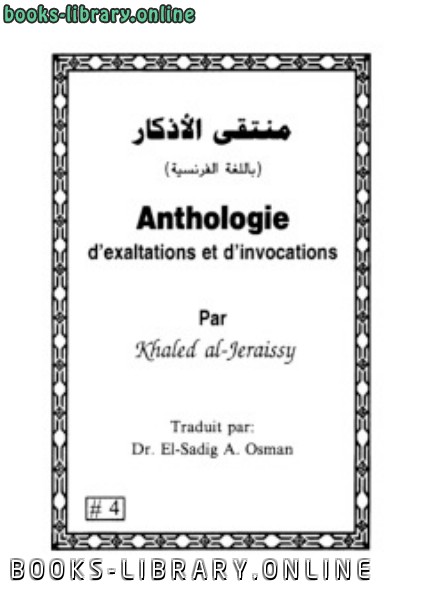
Anthologie d rsquo exaltations et d rsquo invocations PDF
قراءة و تحميل كتاب Anthologie d rsquo exaltations et d rsquo invocations PDF مجانا
